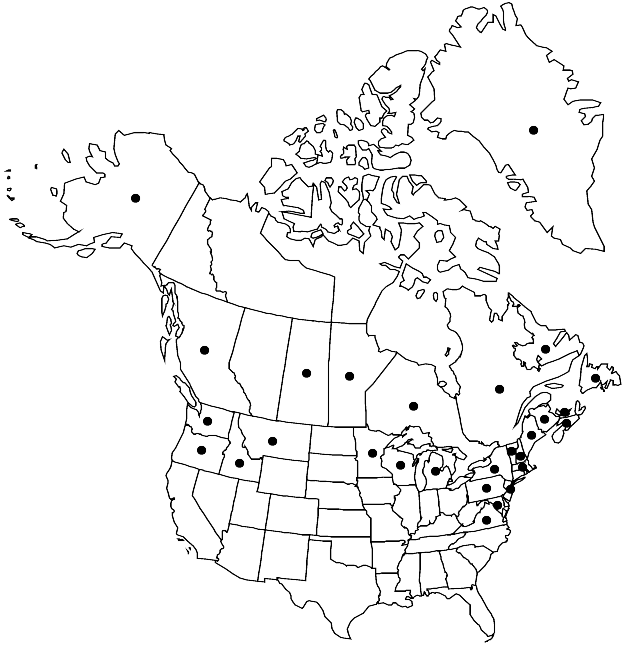Sciuro-hypnum reflexum
Arctoa 11: 270. 2003.
Plants small to medium-sized, soft, in dense or loose tufts, green to dark green or brownish, occasionally light green. Stems to 5 (–8) cm, creeping to arching, terete-foliate, irregularly or rarely regularly pinnate, branches to 8 mm, often curved, spreading-foliate. Stem-leaves appressed to stem at bases, spreading to reflexed distally, ± loosely arranged, occasionally imbricate, ovate or ovate-triangular, concave, not or indistinctly plicate, 1–1.5 (–2) × 0.5–0.9 (–1.2) mm; base broadly long-decurrent; margins plane or recurved proximally, serrulate throughout, sometimes almost entire; apex gradually to abruptly long-acuminate; costa ending in acumen, often obscure distally, terminal abaxial spine absent; alar cells enlarged, 15–30 × 12–20 µm, walls as thick as in laminal cells, region conspicuous, pellucid or opaque (by collapsed cytoplasm); laminal cells short to moderately elongate, 25–70 (–90) × 6–10 (–12) µm; basal juxtacostal cells almost undifferentiated, slightly and gradually shorter than laminal cells, region almost undifferentiated, in 3–10 rows. Branch leaves usually closely imbricate, narrowly ovate to ovatelanceolate; distal laminal cells smooth. Sexual condition autoicous, rarely paroicous. Seta dark redbrown, 0.8–1.5 cm, rough. Capsule inclined to horizontal, dark redbrown or occasionally light-brown, short-ovate to occasionally ovate-cylindric, if longer then curved, 1–1.5 mm. Spores (10–) 12–17 µm.
Habitat: Base of trees, hardwoods, conifers, wood and litter in boreal and hemiboreal forests
Elevation: low to moderate elevations (0-1300 m)
Distribution

Greenland, B.C., Man., N.B., Nfld. and Labr., N.S., Ont., P.E.I., Que., Sask., Alaska, Idaho, Maine, Md., Mass., Mich., Minn., Mont., Oreg., N.H., N.J., N.Y., Pa., Vt., Va., Wash., Wis., Europe, Asia, Atlantic Islands, Pacific Islands
Discussion
Sciuro-hypnum reflexum is characterized by the costa vanishing in the acumen, and the deltoid, broadly decurrent leaves. Sciuro-hypnum reflexum is distinguished from other species in eastern North America by small plants, curved branches, and numerous shortly ovate capsules on rough setae. The situation in western North America is more complicated: typical plants as described above occur in Alaska and British Columbia, but there are also plants described as Brachythecium reflexum var. pacificum Renauld & Cardot, distributed from the mountains of Idaho and Montana to Alaska. Variety pacificum differs from typical S. reflexum mainly in longer laminal cells and longer stems with distantly spaced branches. However, the gradual transition to typical S. reflexum precludes the segregation of var. pacificum as a separate taxon at the moment. Superficially, var. pacificum is somewhat similar to a weakly developed S. oedipodium, and without examination under the compound microscope they can be confused because the costa, although vanishing in the acumen, is weak and not differentiated in color. The alar regions occupy the distal part of the decurrency, extending to the broadest point of the leaf at 1/7 the leaf length, and reach from the margin usually more than halfway to the costa.
Selected References
None.
Lower Taxa
"long" is not a number."broad" is not a number.
